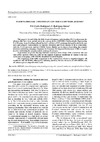Please use this identifier to cite or link to this item:
https://accedacris.ulpgc.es/handle/10553/55601
| DC Field | Value | Language |
|---|---|---|
| dc.contributor.author | Cortés-Rodríguez, F. J. | en_US |
| dc.contributor.author | Rodríguez-Juárez, Carolina | en_US |
| dc.date.accessioned | 2019-06-03T08:18:40Z | - |
| dc.date.available | 2019-06-03T08:18:40Z | - |
| dc.date.issued | 2018 | en_US |
| dc.identifier.issn | 1812-3228 | en_US |
| dc.identifier.uri | https://accedacris.ulpgc.es/handle/10553/55601 | - |
| dc.description.abstract | This paper is framed within the field of natural language understanding (NLU) and presents the advances that have been carried out in the parsing device ARTEMIS (“Automatically Representing Text Meaning via an Interlingua-Based System”), which is a NLU prototype designed to obtain the syntactic and semantic representation of linguistic structures and which consists of three submodules: while the CLS Constructor and the COREL Scheme Builder are in charge of providing the semantic structures underlying a language fragment, the Grammar Development Environment (GDE) is responsible for establishing the morphosyntactic makeup of sentences. In particular, we present the steps that have been taken in the design of the production rules and value added matrixes within the GDE for the analysis of phrasal constituents in relation to the controlled natural language, ASD-STE100, Simplified Technical English. The adaptation of the GDE components to the requirements of such a simplified English will benefit not only ARTEMIS, offering it a validating platform, but also the users of ASD-STE100, who will obtain a parser adapted to their needs. | en_US |
| dc.language | eng | en_US |
| dc.relation.ispartof | Voprosy Kognitivnoy Lingvistiki | en_US |
| dc.source | Voprosy Kognitivnoy Lingvistiki [ISSN 1812-3228], n. 3, p. 97-109 | en_US |
| dc.subject | 57 Lingüística | en_US |
| dc.subject.other | ARTEMIS | en_US |
| dc.subject.other | Natural language understanding | en_US |
| dc.subject.other | Parsing rules | en_US |
| dc.subject.other | Phrasal constituents | en_US |
| dc.subject.other | Simplified technical English | en_US |
| dc.title | Parsing phrasal constituents in ASD-STE100 with artemis | en_US |
| dc.type | info:eu-repo/semantics/article | en_US |
| dc.type | Article | es |
| dc.identifier.doi | 10.20916/1812-3228-2018-3-97-109 | |
| dc.identifier.scopus | 85062112584 | |
| dc.contributor.orcid | #NODATA# | - |
| dc.contributor.orcid | #NODATA# | - |
| dc.contributor.authorscopusid | 55840257700 | |
| dc.contributor.authorscopusid | 56469790200 | |
| dc.description.lastpage | 109 | - |
| dc.identifier.issue | 3 | - |
| dc.description.firstpage | 97 | - |
| dc.investigacion | Artes y Humanidades | en_US |
| dc.type2 | Artículo | en_US |
| dc.identifier.ulpgc | Sí | es |
| dc.description.sjr | 0,105 | |
| dc.description.sjrq | Q3 | |
| item.fulltext | Con texto completo | - |
| item.grantfulltext | open | - |
| crisitem.author.dept | GIR IATEXT: Variación y Cambio Lingüístico | - |
| crisitem.author.dept | IU de Análisis y Aplicaciones Textuales | - |
| crisitem.author.dept | Departamento de Filología Moderna, Traducción e Interpretación | - |
| crisitem.author.orcid | 0000-0001-6711-8597 | - |
| crisitem.author.parentorg | IU de Análisis y Aplicaciones Textuales | - |
| crisitem.author.fullName | Rodríguez Juárez, Carolina Fátima | - |
| Appears in Collections: | Artículos | |
Items in accedaCRIS are protected by copyright, with all rights reserved, unless otherwise indicated.
